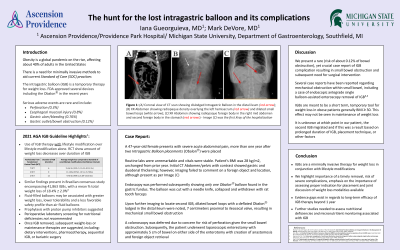Back


Poster Session A - Sunday Afternoon
Category: Obesity
A0599 - The Hunt for the Lost Intragastric Balloon and Its Complications
Sunday, October 23, 2022
5:00 PM – 7:00 PM ET
Location: Crown Ballroom

Has Audio

Iana Gueorguieva, MD
Ascension Providence Hospital/Michigan State University College of Human Medicine
Rochester hills, MI
Presenting Author(s)
Iana Gueorguieva, MD, Mark DeVore, MD
Ascension Providence Hospital/Michigan State University College of Human Medicine, Southfield, MI
Introduction: Obesity is a global pandemic on the rise, affecting about 40% of adults in the United States. There is a need for minimally invasive methods to aid current standard of care practices. The intragastric balloon (IGB) is a temporary therapy for weight loss, with the FDA approving several devices including the ObalonⓇ in the recent years. In 2021, AGA published clinical practice guidelines on Intragastric Balloons in the management of obesity. Serious adverse events are relatively rare in patients receiving IGB treatment, and include injury to the gastrointestinal (GI) tract, such as perforation (0.3%), esophageal mucosal injury (0.8%), gastric ulcer/bleeding (0.76%), and gastric outlet/bowel obstruction (0.12%).
Case Description/Methods: A 47-year-old female with a medical history including two intragastric balloon placements (ObalonⓇ) one year ago, presented with severe acute abdominal pain. Patient’s BMI was 28 kg/m2. Routine labs were unremarkable and vitals were stable. Initial CT Abdomen/pelvis with contrast showed gastric and duodenal thickening; however, imaging failed to comment on a foreign object and location. A gastroscopy was performed subsequently showing one Obalon balloon found in the gastric fundus. The balloon was cut with a needle knife, collapsed and withdrawn with rat tooth forceps. To locate the second balloon, repeat imaging showed dilated bowel loops with a deflated ObalonⓇ lodged in the distal ileum, 7 centimeters proximal to ileocecal valve, resulting in mechanical small bowel obstruction. A colonoscopy was deferred due to concern for risk of perforation given the small bowel obstruction. Subsequently, the patient underwent laparoscopic enterectomy with approximately 5 cm of bowel on either side of the enterotomy with creation of anastomosis and foreign object retrieval.
Discussion: Intragastric balloons are a minimally invasive therapy for weight loss in conjunction with lifestyle modifications in the war against obesity. We present a rare, yet crucial case report of IGB complication resulting in small bowel obstruction and subsequent need for surgical intervention. IGBs are meant to be a short term, temporary tool for weight loss in obese patients generally BMI ≥ 30. This case highlights the importance of a timely removal, risk of severe complications, and emphasis on the importance of assessing proper indication for placement.

Disclosures:
Iana Gueorguieva, MD, Mark DeVore, MD. A0599 - The Hunt for the Lost Intragastric Balloon and Its Complications, ACG 2022 Annual Scientific Meeting Abstracts. Charlotte, NC: American College of Gastroenterology.
Ascension Providence Hospital/Michigan State University College of Human Medicine, Southfield, MI
Introduction: Obesity is a global pandemic on the rise, affecting about 40% of adults in the United States. There is a need for minimally invasive methods to aid current standard of care practices. The intragastric balloon (IGB) is a temporary therapy for weight loss, with the FDA approving several devices including the ObalonⓇ in the recent years. In 2021, AGA published clinical practice guidelines on Intragastric Balloons in the management of obesity. Serious adverse events are relatively rare in patients receiving IGB treatment, and include injury to the gastrointestinal (GI) tract, such as perforation (0.3%), esophageal mucosal injury (0.8%), gastric ulcer/bleeding (0.76%), and gastric outlet/bowel obstruction (0.12%).
Case Description/Methods: A 47-year-old female with a medical history including two intragastric balloon placements (ObalonⓇ) one year ago, presented with severe acute abdominal pain. Patient’s BMI was 28 kg/m2. Routine labs were unremarkable and vitals were stable. Initial CT Abdomen/pelvis with contrast showed gastric and duodenal thickening; however, imaging failed to comment on a foreign object and location. A gastroscopy was performed subsequently showing one Obalon balloon found in the gastric fundus. The balloon was cut with a needle knife, collapsed and withdrawn with rat tooth forceps. To locate the second balloon, repeat imaging showed dilated bowel loops with a deflated ObalonⓇ lodged in the distal ileum, 7 centimeters proximal to ileocecal valve, resulting in mechanical small bowel obstruction. A colonoscopy was deferred due to concern for risk of perforation given the small bowel obstruction. Subsequently, the patient underwent laparoscopic enterectomy with approximately 5 cm of bowel on either side of the enterotomy with creation of anastomosis and foreign object retrieval.
Discussion: Intragastric balloons are a minimally invasive therapy for weight loss in conjunction with lifestyle modifications in the war against obesity. We present a rare, yet crucial case report of IGB complication resulting in small bowel obstruction and subsequent need for surgical intervention. IGBs are meant to be a short term, temporary tool for weight loss in obese patients generally BMI ≥ 30. This case highlights the importance of a timely removal, risk of severe complications, and emphasis on the importance of assessing proper indication for placement.

Figure: Figure 1: (A) Coronal view of CT scan showing dislodged Intragastric Balloon in the distal ileum (red arrow); (B) XR Abdomen showing radiopaque density overlying the left hemisacrum (red arrow) and dilated small bowel loops; (C) XR Abdomen Complete w/ Decub/Erect showing radiopaque foreign body in the right mid abdomen and second foreign body in the stomach (red arrows)
Disclosures:
Iana Gueorguieva indicated no relevant financial relationships.
Mark DeVore indicated no relevant financial relationships.
Iana Gueorguieva, MD, Mark DeVore, MD. A0599 - The Hunt for the Lost Intragastric Balloon and Its Complications, ACG 2022 Annual Scientific Meeting Abstracts. Charlotte, NC: American College of Gastroenterology.
